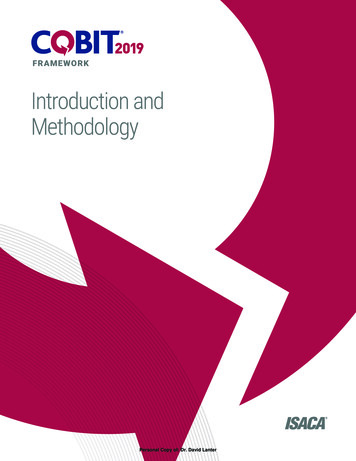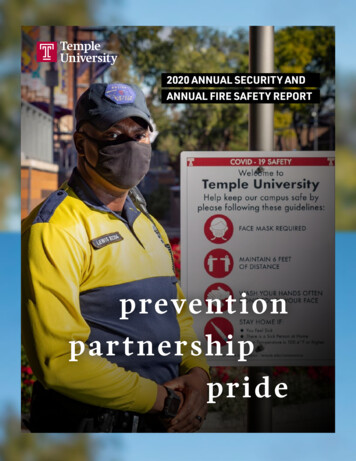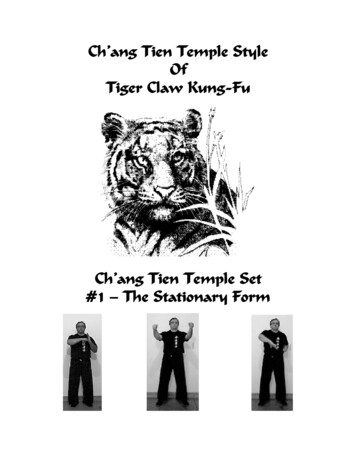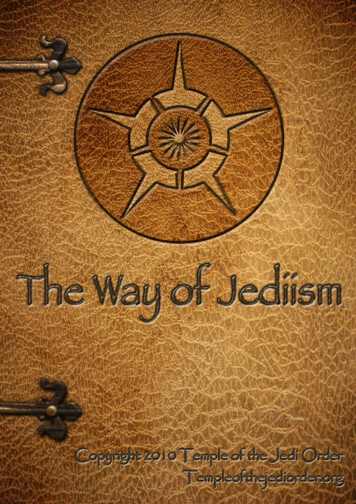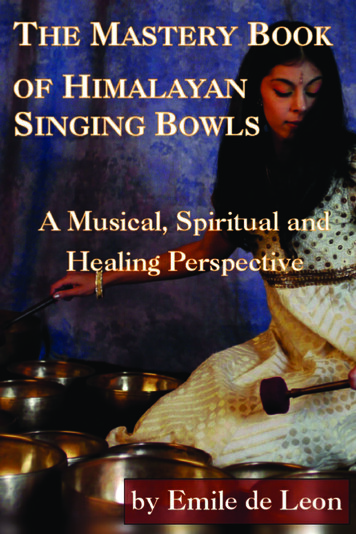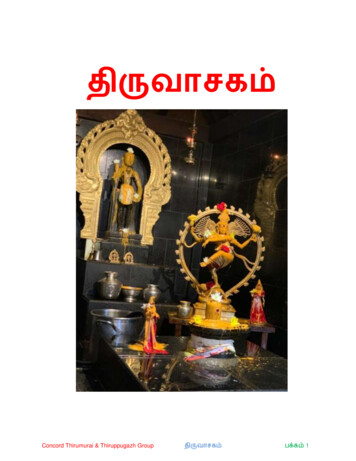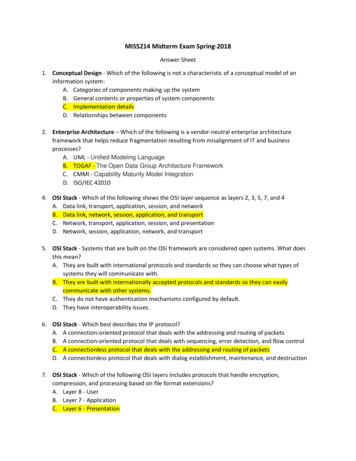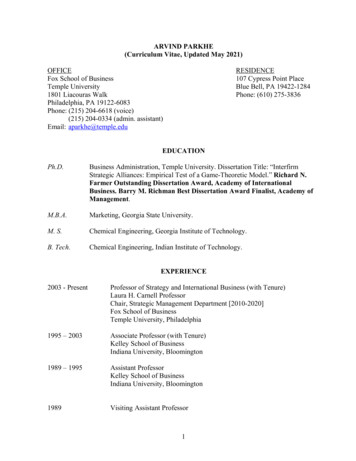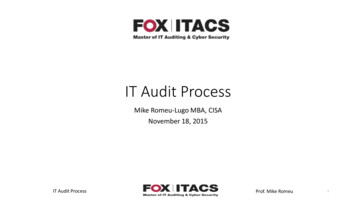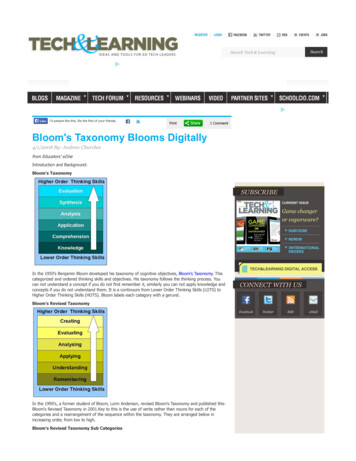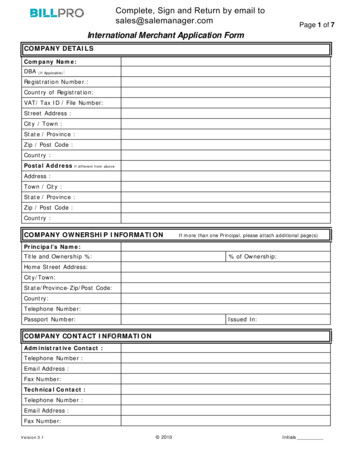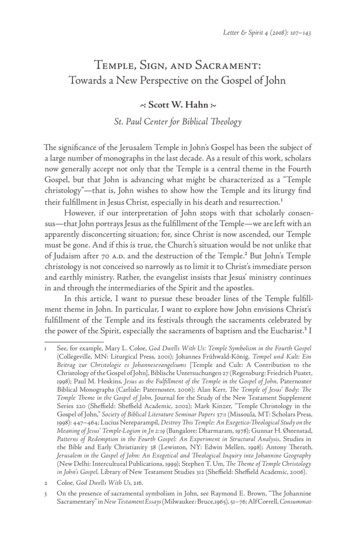
Transcription
Letter & Spirit 4 (2008): 107–143Temple, Sign, and Sacrament:Towards a New Perspective on the Gospel of John1 Scott W. Hahn 2St. Paul Center for Biblical TheologyThe significance of the Jerusalem Temple in John’s Gospel has been the subject ofa large number of monographs in the last decade. As a result of this work, scholarsnow generally accept not only that the Temple is a central theme in the FourthGospel, but that John is advancing what might be characterized as a “Templechristology”—that is, John wishes to show how the Temple and its liturgy findtheir fulfillment in Jesus Christ, especially in his death and resurrection. However, if our interpretation of John stops with that scholarly consensus—that John portrays Jesus as the fulfillment of the Temple—we are left with anapparently disconcerting situation; for, since Christ is now ascended, our Templemust be gone. And if this is true, the Church’s situation would be not unlike thatof Judaism after 70 a.d. and the destruction of the Temple. But John’s Templechristology is not conceived so narrowly as to limit it to Christ’s immediate personand earthly ministry. Rather, the evangelist insists that Jesus’ ministry continuesin and through the intermediaries of the Spirit and the apostles.In this article, I want to pursue these broader lines of the Temple fulfillment theme in John. In particular, I want to explore how John envisions Christ’sfulfillment of the Temple and its festivals through the sacraments celebrated bythe power of the Spirit, especially the sacraments of baptism and the Eucharist. I See, for example, Mary L. Coloe, God Dwells With Us: Temple Symbolism in the Fourth Gospel(Collegeville, MN: Liturgical Press, 2001); Johannes Frühwald-König, Tempel und Kult: EinBeitrag zur Christologie es Johannesevangeliums [Temple and Cult: A Contribution to theChristology of the Gospel of John], Biblische Untersuchungen 27 (Regensburg: Friedrich Pustet,1998); Paul M. Hoskins, Jesus as the Fulfillment of the Temple in the Gospel of John, PaternosterBiblical Monographs (Carlisle: Paternoster, 2006); Alan Kerr, The Temple of Jesus’ Body: TheTemple Theme in the Gospel of John, Journal for the Study of the New Testament SupplementSeries 220 (Sheffield: Sheffield Academic, 2002); Mark Kinzer, “Temple Christology in theGospel of John,” Society of Biblical Literature Seminar Papers 37:1 (Missoula, MT: Scholars Press,1998): 447–464; Lucius Nereparampil, Destroy This Temple: An Exegetico-Theological Study on theMeaning of Jesus’ Temple-Logion in Jn 2:19 (Bangalore: Dharmaram, 1978); Gunnar H. Østenstad,Patterns of Redemption in the Fourth Gospel: An Experiment in Structural Analysis, Studies inthe Bible and Early Christianity 38 (Lewiston, NY: Edwin Mellen, 1998); Antony Therath,Jerusalem in the Gospel of John: An Exegetical and Theological Inquiry into Johannine Geography(New Delhi: Intercultural Publications, 1999); Stephen T. Um, The Theme of Temple Christologyin John’s Gospel, Library of New Testament Studies 312 (Sheffield: Sheffield Academic, 2006). Coloe, God Dwells With Us, 216. On the presence of sacramental symbolism in John, see Raymond E. Brown, “The JohannineSacramentary” in New Testament Essays (Milwaukee: Bruce,1965), 51–76; Alf Correll, Consummat-
108 Scott W. Hahnpresent this article as more exploratory than demonstrative. That said, by bringingtogether some of the most fruitful findings of Johannine scholarship, I hope thisreading of John will offer a new perspective on the many signs Jesus performed inthe presence of his disciples and the relationship of those signs to the new life thatJohn wishes to communicate by his writing (see John 20:30–31).I will begin by briefly reviewing the depiction of the Temple in the OldTestament and its significance for the old covenant People of God. This will enableus to better understand how John’s first-century Jewish readers would have receivedhis identification of Jesus as the replacement of the Temple and its festivals.Following that, I will examine the first Passover narrative in John (2:13–3:21).This will show three things: First, that John depicts Jesus as the “new Temple”at the outset of his public ministry, a theme he pursues throughout his gospel.Second, that Jesus performs his “signs” in the context of this broader fulfillment ofthe Temple and the Temple festivals. Third, that in the dialogue with Nicodemus,Jesus moves from his “signs” to the sacrament of baptism, that is, rebirth by theSpirit (John 3:3, 5).I will then consider John’s narratives of the second Passover (John 6) and theFeast of Tabernacles (John 7–9). I hope to show that in these accounts, too, Jesusfunctions as new Temple, that the Temple festivals are the context for Jesus’ “signs,”and that the “signs” he performs point forward to the sacraments of baptism andthe Eucharist.Moving to the third and final Passover narrative of the gospel (John11:55–20:31), I will focus on Jesus’ last discourse (John 13–17), in which he conferson the disciples his own “Templeness” and commissions them to continue hismission—indeed, to perform “greater works than these.” I will suggest that theum Est: Eschatology and Church in the Gospel of St. John (New York: Macmillan, 1958); OscarCullmann, Early Christian Worship, trans. A. Stewart Todd and James B. Torrance, Studiesin Biblical Theology 10 (London: SCM, 1953); Frederick W. Guyette, “Sacramentality in theFourth Gospel: Conflicting Interpretations,” Ecclesiology 3 (2007): 235–250; Francis J. Moloney,“When is John Talking about the Sacraments?” in “A Hard Saying”: The Gospel and Culture(Collegeville, MN: Liturgical Press, 2001), 109–130; P. Paul Niewalda, Sakramentssymbolik imJohannesevangelium? Eine Exegetisch-Historische Studie [Sacramental Symbolism in the Gospelof John? An Exegetical-Historical Study (Limburg: Lahn-Verlag, 1958); Bruce Vawter, “TheJohannine Sacramentary,” Theological Studies 17 (1956): 151–166. Johannine scholars range fromthe anti- or non-sacramental to the ultra-sacramental. Writing near the end of his life RaymondBrown claimed: “Most scholars recognize some form of sacramentalism” (An Introduction to theGospel of John, ed. Francis J. Moloney [New York: Doubleday, 2003], 231). Brown’s own moderateapproach, outlined in “The Johannine Sacramentary” and pursued in his various commentaries,recommends itself for its exegetical common sense. Ironically, it is from Baptist scholar DavidAune that one finds one of the most forceful defenses of sacramental and liturgical allusionsin John: “It would therefore be incorrect to claim that basic elements of congregationallife, worship, sacraments and the ministry play only insignificant roles in the Fourth Gospel.Such elements do not receive explicit treatment precisely because they are the presuppositions of theecclesial context out of which the gospel arose.” See The Cultic Setting of Realized Eschatology in EarlyChristianity, Supplements to Novum Testamentum 28 (Leiden: Brill, 1972), 73. Emphasis mine.Temple, Sign, and Sacrament 109sacraments fall under this category of “greater works,” and that this interpretation is supported by consideration of John 19:34, which symbolically depicts thesacraments flowing from the death and resurrection of Christ, and John 20:22–23,in which the apostles receive the Spirit in order to perform the “greater work” ofremitting sins.This exploration will allow me to suggest the following conclusion: that, ifone follows the logic and symbolism of John’s Gospel, the sacraments, primarilybaptism and Eucharist, truly are the specific times and places where the believercontinues to experience Christ as the new Temple. Having established this centralthesis, I will make some corollary conclusions in a brief theological reflection.The Embodiment of God’s Covenant with DavidThe literature on both the historical role of the Temple in Israel and its literaryimportance in the Scriptures is enormous. From this literature, I want to stressthe following points:First, the Temple was the embodiment of God’s covenant with David. Thecentral text of the Davidic covenant (2 Sam. 7:8–16), focuses on a son of David whowill build a “house” for God (that is, the Temple), and for whom God will build a“house” (that is, a dynasty). The immediate, though penultimate, fulfillment of thiscovenant was found in David’s son, Solomon, who, like David, was an “anointed” See, for example, the brief reviews by Coloe, God Dwells With Us, 31–63; and Hoskins, Jesus asthe Temple, 38–107, and longer treatments by G. K. Beale, The Temple and the Church’s Mission:A Biblical Theology of the Dwelling Place of God, New Studies in Biblical Theology 17 (Downer’sGrove, IL: InterVarsity, 2004); Jon D. Levenson, “The Temple and the World,” Journal of Religion64 (1984): 275–298; John M. Lundquist, “What is a Temple? A Preliminary Typology,” in TheQuest for the Kingdom of God: Studies in Honor of George E. Mendenhall, eds. H. B. Huffmon,F. A. Spina, and A. R. W. Green (Winona Lake, IN: Eisenbrauns, 1983); Lundquist, “TheLegitimizing Role of the Temple in the Origin of the State,” Society of Biblical Literature SeminarPapers 21 (Missoula, MT: Scholars Press, 1982): 271–297; Lundquist, “Temple, Covenant, andLaw in the Ancient Near East and in the Old Testament,” in Israel’s Apostasy and Restoration:Essays in Honor of Roland K. Harrison, ed. Avraham Gileadi (Grand Rapids, MI: Baker, 1988),293–305; Donald W. Parry, “Garden of Eden: Prototype Sanctuary,” in Temples of the AncientWorld: Ritual and Symbolism (Salt Lake City: Deseret, 1994), 126–151; Raphael Patai, Man andTemple in Ancient Jewish Myth and Ritual (New York: Ktav, 1967). “The Temple was the embodiment of the covenant of David, in which the triple relationshipbetween Yahweh, the House of David, and the people of Israel was established.” Toomo Ishida,The Royal Dynasties in Ancient Israel. A Study on the Formation and Development of Royal-DynasticIdeology, Beiheft zur Zeitschrift für die Alttestamentliche Wissenschaft 142 (New York: W. deGruyter, 1977), 145; “Reinforcing the covenant with David, which formulated Yahweh’s electionof him, the Temple now testified to Yahweh’s election of Mount Zion as his eternal dwellingplace” (Ishida, Royal Dynasties, 147). Besides the work of Ishida, we may mention the extensiveresearch of John M. Lundquist (see n. 4 above), much of it collected in Temples of the AncientWorld. Lundquist demonstrates the key position of the temple in the center of the ancientNear Eastern world-view or cosmology, not only for Israel’s neighbors (Egyptian, Canaanite,Mesopotamian, or Hittite cultures) but for Israel herself, as reflected in the Old Testament.
110 Scott W. Hahnone—that is, a “Messiah” (Hebrew) or “Christ” (Greek). He also enjoyed thestatus of “son of God” according to the terms of the covenant. In Solomon wehave a “Christ,” a Temple-builder, and the first individual in the canon of Scriptureto be described as “son of God.”Second, the Temple was the dwelling place of God’s “name,” his “glory,” andfinally, God himself.10 Third, the Temple was the place of pilgrimage. Three timesa year, all the men of Israel were required to journey to the Temple to celebratethe feasts of Passover, Pentecost, and Tabernacles.11 For Israelites, participatingin these feasts meant undergoing water washings (ablutions) to enter a state ofritually purity.12 Only then were Israelites able to offer sacrifice13 and participatein the feast, which principally involved eating:14 usually the meat of the sacrifice,15with bread16 and wine,17 the fruits of the Promised Land.18 Through participationin these Temple sacrifices, Israelites made atonement for their sins.19 The entireexperience of the Temple—the ritual washings, the sacrifice, the eating and drinking, and the remission of sin—was only possible because of the work of the Templeministers: the High Priest, his fellow priests, and the Levites.Finally, a new Temple, often with divine properties, is a central feature of theeschatology of some of the prophets,20 and at least an important feature in several 1 Kings 1:34, 39. 2 Sam. 7:14; Ps. 2:6–7. Deut. 16:2; Ps. 74:7. 1 Kings 8:10–11; Ezek. 43:2–5.10 Ps. 68:16; Ezek. 43:6.11Deut. 16:1–17.12Exod. 19:10–11; 2 Chron. 30:17–20; Lev. 11–15; esp. 15:31. The necessity of water washings is notexplicit in the Pentateuch’s descriptions of the feast, but it was required by the logic of the laws ofcleanliness in Lev. 11–15 and elsewhere. The penalty for defiling the sanctuary with uncleannesswas death (Lev. 15:31); therefore, worshipers had to be ritually clean. Moreover, there were awide variety of causes of unseemliness (see Lev. 11–15); thus, the average Israelite would needto purify himself by ritual washing at some point before participating in one of the Templefestivals. Archeologists have found large numbers of miqva’ot—ritual baths—in Jerusalem andits environs, used for these ritual cleansings during the Second Temple period.13Deut. 16:2, 6; Lev. 23:8.14 Deut. 16:3, 7–8; see also Lev. 7:11–17; 2 Chron. 30:22; Isa. 25:6.15Deut 16:4, 7.16Deut 16:3; Lev. 23:6.17Isa. 25:6; Luke 22:18, 20.18Deut. 16:13. Although the texts cited are largely for the feast of Passover, celebratory eatingwas an important part of all the feasts, even when not mentioned in the biblical descriptions.All three pilgrimage feasts (Passover, Pentecost, Tabernacles) marked important agriculturalevents (barley harvest, wheat harvest, and fruit harvest, respectively) and were natural times toenjoy the Creator’s abundant gifts, similar to the American holiday, Thanksgiving.19See, for example, Lev. 4:20, 26, 35; 5:10, 13; 19:22; 15:25.20 For example, Ezek. 40–48 and Joel 3:17–18.Temple, Sign, and Sacrament 111others21—especially when one takes into account the relationship of the Temple,Zion, and Jerusalem.22 It will be useful to bear in mind these points concerning theTemple as we proceed to explore John’s deployment of Temple and Temple-festivalmotifs i
110 Scott W. Hahn Temple, Sign, and Sacrament 111 others —especially when one takes into account the relationship of the Temple, Zion, and Jerusalem. It will be useful to bear in mind these points concerning the Temple as we proceed to explore John’s deployment of Temple and Temple-festival motifs in his gospel, especially in relation to Jesus. The First Passover and the Cleansing of the .
